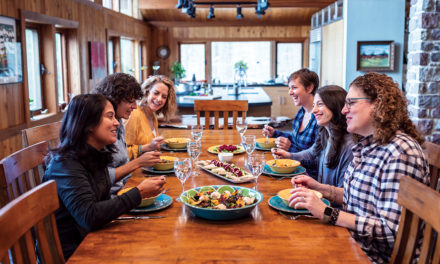These days, it seems like everyone has tried—or wants to try—a high-protein, low-carb diet. But is it safe, or even healthy? Here’s what you need to know.

Juliana Gebb had just turned 41 and run a marathon when, after her annual gynecology appointment, when she learned her blood sugar was in the prediabetes range.
“I was shocked,” says Gebb, a surgeon and mom of four. “Even my doctor told me she didn’t have any indication to have the lab check my hemoglobin A1C, a measure of blood glucose over 3 months, but I told her to go for it. I’m thin. I run marathons. I thought I’d have no problem whatsoever.”
But when the bloodwork came back, it prompted Gebb to really think about her diet. Maybe those sugar-filled foods she reached for to keep her energy up during long shifts at the hospital were having more of an impact than she realized. Perhaps the carbohydrate-rich grains she ate to sustain her training runs were actually hurting, not helping, her health. Those lab results were a wake-up call, says Gebb. “I started reading about how I could change my blood glucose numbers by changing my diet, and I stopped having sugar of any kind, in any form, and started getting my carbohydrates almost exclusively via vegetables.”
What is Keto?
Gebb essentially started following a ketogenic diet—a high-protein, high-fat, low-carb eating plan that helps your body burn its own fat for energy. This low-sugar, low-starch way of eating is having a major moment. According to a recent survey of dietitians, keto was one of the top nutrition trends of 2020. There’s a good reason for this, says Julie Brunner, a certified health coach in Yardley, Pa.: It works. “Keto can be especially great for those with certain diseases, like diabetes and epilepsy,” she says. (In fact, the keto diet was originally designed to help treat people with seizure disorders.) “And there’s no question it can help you lose weight.”
Yet, along with all of the positive buzz, there’s a good chance you’ve also heard about how tough the diet is to stick with over the long haul. On a strict plan, you can’t have more than 20 grams of carbohydrates a day. (To put that in perspective, just one apple has 25 grams of carbohydrates and a whole wheat bagel has 51 grams of carbs.) That means you’ll get just about 5 percent of your daily calories from carbohydrates, 25 percent from protein, and 70 percent from fat—ratios that put your body into a state called ketosis. When you avoid eating foods that raise your blood sugar (read: simple carbs and sugar), you force your body to create an alternative fuel called ketones, which prompts your body to use the fat you eat for energy. Bonus: Ketosis also prompts your body to dip into excess fat you’ve already got stored, which is what leads so many people who follow this diet to lose weight and stubborn body fat—fast.
Many women are turning to the diet for reasons other than fat loss. When Brittany Lermitte’s high-intensity interval training gym offered a keto challenge, she was curious whether the diet would work for her. The 36-year-old mom of three in Bryn Athyn, Pa., was already fit and didn’t eat a lot of junk food, but she did have a sweet tooth and wanted to see if the low-carb craze would eliminate her sugar cravings and clear up her breakout-prone skin. “Within a few days, I was buzzing with energy,” says Lermitte. “I was also able to go off the oral medication I was taking for my acne. That kind of immediate evidence of how well the diet works is amazing—and the results have inspired me to stick to the diet pretty strictly for the last 2 years.”
I see a lot of people thinking they can eat bacon on bacon wrapped around a pork tenderloin and fried in oil. And while those people will benefit from avoiding sugar, there’s a risk that comes with eating too much processed meat.
5 Fave Keto Blogs
Need some low-carb recipe inspiration? Check out these fan favorites.
Can Keto Help You Fight COVID?
The answer might be yes. According to one recent Yale University study, mice fed a ketogenic diet were better able to combat the flu virus than mice fed high-carb foods. The researchers found the keto diet activated virus-fighting immune cells and reduced inflammatory cells in the lungs. While more research is underway, experts agree doing what you can to reduce inflammation in the body is wise. “Every bite of food you eat either feeds disease or fights disease,” says Brunner. “The more you can crowd out the sugar and simple carbohydrates in your diet by loading up on inflammation-fighting veggies and healthy fats, the better.

Clean Keto
Expert tips for following a high-protein, high-fat, low-carb diet the right way.
Tip No. 1: Load up on veggies. Forget the recommended five servings of vegetables a day, says Brunner, and aim for more like 15. “It may sound like a lot, but this is what contributes to optimal health and feeling your best over time.”
Tip No. 2: Avoid processed meat. Some experts say following a “dirty keto” diet—which gives the green light to any kind of protein and fat you like as long as you keep your daily carbohydrate intake to 30 grams or less—is just as beneficial as “clean keto.” Considering research has shown a link between processed meats and cancer, Brunner suggests opting for organic, grass-fed proteins instead—and keeping serving sizes in check.
Tip No. 3: Reach for whole foods. Grocery store shelves are lined with keto-friendly packaged foods. However, while they may be low in carbs, they’re also filled with processed junk that won’t contribute to optimal health over the long haul, says Brunner.
What the Experts Say
Brunner first started hearing about the keto diet on the gym circuit, she says. “It really burst into popularity among CrossFit fans and the like, and I started getting a lot of questions about it from my clients.” Yet, while keto is still the diet du jour, Brunner says she’s not convinced it’s for everyone.
“There’s a healthy way to follow a low-carb diet, which involves eating a lot of vegetables, healthy fats, and good quality lean meats,” she says. “Unfortunately, I see a lot of people thinking they can eat bacon on bacon wrapped around a pork tenderloin and fried in oil. And while those people will benefit from avoiding sugar, there’s a risk that comes with eating too much processed meat.”
Mindy Komosinsky, RD, a registered dietitian nutritionist and certified diabetes care and education specialist at Capital Health, agrees, adding that following a keto diet can also be really difficult to stick to. “I know some people have success with keto for weight loss and managing their blood glucose, however, it’s very hard diet to sustain,” she says. “My philosophy for nutrition is to choose an eating plan that provides your body with the nutrients it needs and that you can maintain for the rest of your life.”
For both Lermitte and Gebb, the low-carb way of life is sustainable—and it doesn’t include a bacon-on-bacon approach. While Gebb still avoids sugar and dairy, she’s added a bit more fruit, sweet potatoes, and whole grains to her diet and has kept her blood glucose in the normal range for more than a year now. “I have so much more sustained energy these days,” she says.
“In the past, I would’ve stuffed a handful of goldfish crackers in my mouth before doing a C-section. I never feel like I need to do that now—and I don’t miss the sweets I used to crave.”
Lermitte says that although she’ll splurge every so often—she wasn’t going to miss out on tortilla chips on a vacation to Mexico, and she’ll have a piece of cake on her kids’ birthdays—she’s almost completely lost the urge to reach for sweets. “I eat a ton of veggies and other whole foods and almost never have processed stuff,” she says. She’s also learned that many of the foods that aren’t keto-friendly—things like bread, rice, and pasta—are pretty easy to swap out of her meals.
“My family eats whatever they want, so if they’re having rice, I’ll have cauliflower rice,” says Lermitte. “If they’re having bread, I’ll have an almond bread muffin I keep stashed in my freezer. Or, I’ll just swap in extra veggies for the starch.” The best part? Lermitte doesn’t sit at the table wishing she could have the “real” rice or bread. “I can easily watch my husband eat a bagel and it doesn’t bother me,” she says. “After a while, you find that you just don’t miss it anymore.”






